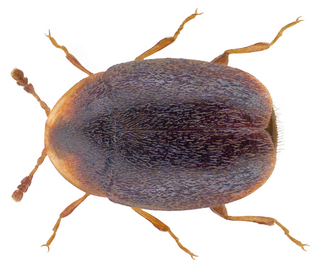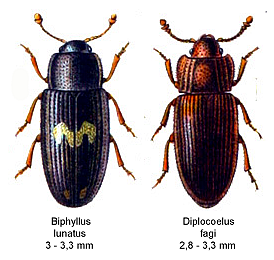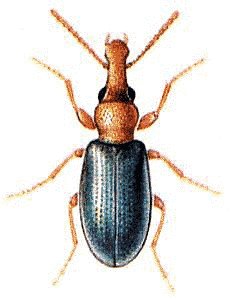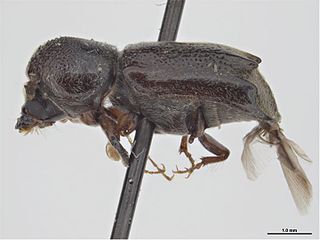
The whirligig beetles are a family (Gyrinidae) of water beetles that usually swim on the surface of the water if undisturbed, though they swim underwater when threatened. They get their common name from their habit of swimming rapidly in circles when alarmed, and are also notable for their divided eyes which are believed to enable them to see both above and below water. The family includes some 700 extant species worldwide, in 15 genera, plus a few fossil species. Most species are very similar in general appearance, though they vary in size from perhaps 3 mm to 18 mm in length. They tend to be flattened and rounded in cross section, in plain view as seen from above, and in longitudinal section. In fact their shape is a good first approximation to an ellipsoid, with legs and other appendages fitting closely into a streamlined surface.
Lutrochidae is a family of water beetles sometimes known as "travertine beetles", since in North America they are common in springs and streams depositing travertine.

Eucinetidae is a family of beetles, notable for their large coxal plates that cover much of the first ventrite of the abdomen, sometimes called plate-thigh beetles. The family is small for beetles, with about 37 species in nine genera, but are found worldwide.

A Beetle Cat is a 12-foot-4-inch (3.76 m) catboat first built in 1920 in New Bedford, Massachusetts by members of the Beetle family. Over 4,000 have been built. Beetle, Inc., now in Wareham, Massachusetts, is the sole builder of Beetle Cat boats.
The family Archeocrypticidae is a small group of beetles with no vernacular common name, though recent authors have coined the name cryptic fungus beetles. Adults and larvae seems to be saprophagous and are often found in plant litter. Worldwide, about 10 genera and 50 species are found, most species are pantropical. Enneboeus caseyi has been recorded from the American South, Central America, and Mexico. About 20 species are found in Australia, in the genera Enneboeus and Australenneboeus.

The family Mycteridae is a small group of beetles with no vernacular common name, though recent authors have coined the name palm and flower beetles. The family Mycteridae is distributed worldwide. There are about 30 genera and 160 species. About 20 species are found in Australian, species of three genera are found in North America

The family Prostomidae is a small group of beetles with no vernacular common name, though recent authors have coined the name jugular-horned beetles. They are often found in dead wood. The family consist of two genera with about 20 species. Prostomis mandibularis is known from North America. Other species of Prostomis are found in Africa, the Pacific region and East Asia. Species of Dryocora are known from New Zealand, Australia and Tasmania.

Corylophidae is a family of minute hooded beetles, sometimes called minute fungus beetles, in the order Coleoptera. There are about 18 genera and at least 120 described species in Corylophidae.

Glaphyridae is a family of beetles, commonly known as bumble bee scarab beetles. There are eight extant genera with about 80 species distributed worldwide and two extinct genera described from the fossil record of China.

Jacobsoniidae is a family of beetles. The larvae and adults live under bark, in plant litter, fungi, bat guano and rotten wood. It is a small family with 23 described species in three genera:

Trogossitidae is a small family of bark-gnawing beetles in the suborder Polyphaga. Trogossitidae consists of about 600 species. 59 species are found in America and about 36 in Australia.

Biphyllidae or False Skin Beetles is a family of beetles, in the suborder Polyphaga. Worldwide, about 195 species are known. They live under the bark of dead trees and feed on fungi. It contains the following genera:

Byturidae, also known as Fruitworms, is a very small family of beetles, in the suborder Polyphaga, comprising fewer than 20 species worldwide. The larvae of some species develop in fruits. Byturus unicolor affects species of Rubus and Geum.

The Mycetophagidae or hairy fungus beetles are a family of beetles in the large suborder Polyphaga. The different species are between 1.0 and 6.5 mm in length. The larvae and adults live in decaying leaf litter, fungi, and under bark. Most species feed on fungi. Worldwide, the 18 genera contain around 200 species.

Stenotrachelidae, commonly called false longhorn beetles is a family of beetles, in the large suborder Polyphaga.

Salpingidae or narrow-waisted bark beetles is a family of beetles, in the large suborder Polyphaga. The species are small, about 1.5 – 7 mm in length. This family is worldwide distributed and consists of about 45 genera and 300 species.

Xylopsocus gibbicollis, common name "common auger beetle", is a species of beetle of the Bostrichidae family.
Eulichadidae is a family of forest stream beetles in the order Coleoptera. There are about 5 genera and more than 40 described species in Eulichadidae.

Xyloperthini is a tribe of horned powder-post beetles in the family Bostrichidae. There are at least 30 genera and 130 described species in Xyloperthini.

Xylopsocus capucinus is a species of horned powder-post beetle in the family Bostrichidae. It is found in Africa, Australia, North America, Oceania, South America, and Southern Asia.




















